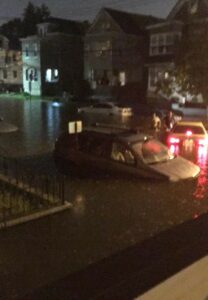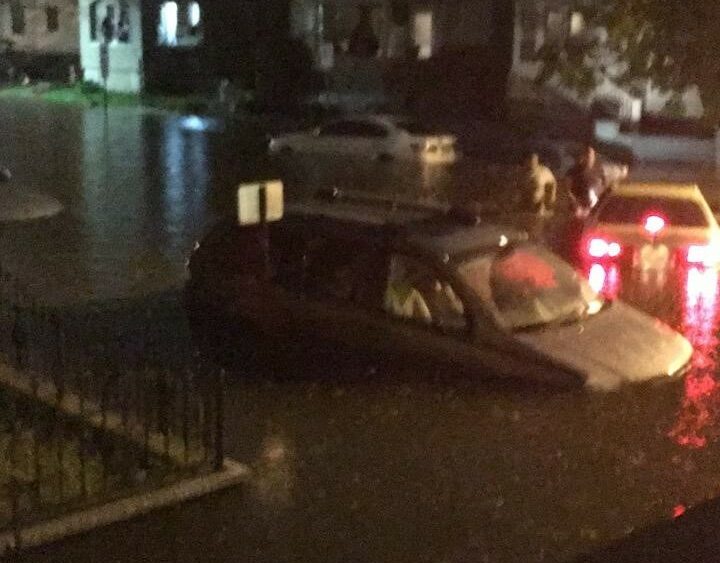By FELICIA CAPERS Contributing Writer Jul 18, 2024
Editor’s note: This story was produced as part of the Northern New Jersey Media Collaborative Project “Stormwater Matters,” a project focusing on stormwater management solutions in the state.
Roaring through 45 municipalities in northern and central New Jersey, the Passaic River, at 80 miles long, is only the 5th longest river in the state. One of its most charming features is the Great Falls in Paterson, where it rushes down a 77-foot cliff. However, how can this natural body of tidal water be the cause of such mayhem?
Historical Flooding And Local Impact


The repair shop owner, Ney Jamie of Paterson’s 1st Ward, guides a tour through his business to show the water marks that still linger on the walls from flooding in March 2024.
It’s remarkable how many times the Army Corps of Engineers reports that the federal government has made a Federal Disaster Declaration due to flooding and damage along the Passaic River: 1968, 1971, 1972,1973, twice in 1975, 1984, 1992, 1999, 2005, 2007, 2010, 2011, and with Superstorm Sandy in 2012. Paterson businesses and homes along Route 20 in the historical Eastside section of Paterson feel the impact, as the river runs along the state highway in the Eastside section and floods when it crests. The flooded highway is enough of a burden.
However, businesses and homes most affected by flood waters entering their homes, causing evacuations, are located in the city’s northside, represented by First Ward Councilman Michael Jackson. He advocates for a study to determine if municipalities north of Paterson have the capacity to dam river waters flowing through their towns and into Paterson. “How responsible are counties and municipalities north of Paterson being?” he asked. “We need to study that.”
Community Voices And Stories Of Impact
Pastor Jason Rogers of Holy Tabernacle Apostolic Church on Holsman Street in Paterson, two blocks from the river in the 1st Ward, recalled years of flooding: “For years before 2012, the church would deal with flooding in the basement. It would cause our heating system to go. In 2011 Hurricane Irene caused flooding. The water wrapped around the entire [church] property.”
Businesses and houses of worship are not the only sufferers. Resident Gwen Benbow’s mother is bedridden. She had to leave her home on Hillman Street, one block from Jamie’s auto shop, by boat. “The fire department had to come get her from the second floor.” Benbow’s mother was away from her home for 2 or 3 weeks during the last storm.
Many people may wonder why residents or businesses won’t leave the area entirely. Locals say that economic challenges play a role. People like Jamie say they can’t afford to move from permanent spots in the community, like his auto shop, and state that flood insurance would cost them nearly $10,000.00 a year. “I can’t afford that,” he said. Watermarks from the last round of flooding in March are still visible at over five feet high on the walls of his auto shop. It was the third flood in three months that the area sustained.
A Councilman’s Perspective, Root Causes And Potential Fixes
Jackson, who majored in engineering in college, attributes the constant flooding to a few culprits. “Water levels are rising higher than the sewer system,” he opined. “There is also overdevelopment in our communities.”
He explained that, now, urban spaces are being covered by concrete, unlike years ago when rainwater could be absorbed by the surrounding land. “We have allowed people to build on every square foot of a property, and that’s too much. There is an accumulation of water [when it rains] with nowhere to go.”
In addition to studying what up-county municipalities can do to help control the flow of the Passaic River downstream into low-lying areas like Paterson, Jackson wants the City of Paterson officials to enforce building codes and even create new ones, if need be, that requires a certain amount of area space not to be built upon when new structures go up or when old structures are renovated.
Lastly, he added that dredging the Passaic River to rid it of garbage and other bulk particles could help the flooding, too. Jamie agrees. “I was told by the mayor’s office that it’s the governor’s office that can give the money to clean up the river and maybe it won’t flood like this anymore.”
REPRINTED WITH PERMISSION FROM NEW JERSEY HILLS MEDIA
